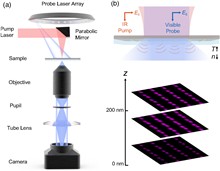 View fulltext
View fulltext
The commentary discusses a recent report of metasurface-enhanced infrared photothermal (MEIP) microscopy, which simultaneously overcomes long-standing sensitivity and spatial resolution barriers in midinfrared spectroscopy, advanc
In the past two decades, optogenetic technology has developed to be the most accurate method for investigating or treating neural correlated diseases. Currently, the applications of optogenetic technology have been expanded from t
Computational imaging (CI) leverages the joint optimization of optical system design and reconstruction algorithms, enabling superior performance in terms of dimensionality, resolution, efficiency, and hardware complexity. It has
Quantum theory of photons based on the first quantization technique, similar to that used by Schrödinger in the formulation of quantum mechanics, is considered. First, scalar quantum mechanics of photons operating with the photon
Infrared spectroscopy with its rich vibrational information plays a crucial role in biochemical sensing. Metasurface-enhanced infrared spectroscopy amplifies the detection sensitivity by enhancing local electromagnetic fields. How
Visible optical frequency combs are essential to optical atomic clocks, astronomical spectrograph calibration, and biological imaging. However, due to the limitations of the dispersion properties of available materials and the Q-f
Quantum-confined Stark effects (QCSEs), where external or built-in electric fields modify optical transition energies, have garnered significant interest due to their potential for tuning emission energies to couple with quantum d
Holography plays a crucial role in optics, yet traditional methods require complex setups and bulky devices, being unfavourable for optical integration. Although metasurface-based holograms can be ultra-compact, holographic images
Robust three-dimensional (3D) recognition across different viewing angles is crucial for dynamic applications such as autonomous navigation and augmented reality; however, the application of the technology remains challenging owin
All-inorganic CsPbBr3 perovskite polycrystalline films, renowned for their remarkable optoelectronic properties, solution processability, and enhanced stability over organic–inorganic counterparts, are emerging as next-generation
Convolutional operations are computationally intensive in artificial intelligence (AI) services, and their overhead in electronic hardware limits machine learning scaling. Here, we introduce a photonic joint transform correlator (
















